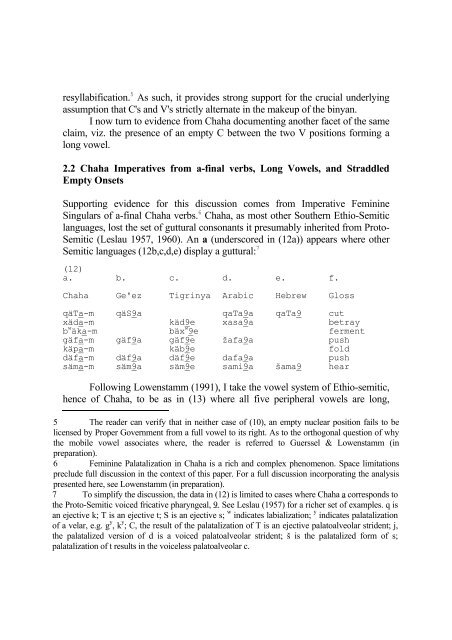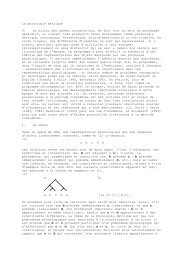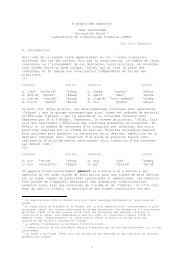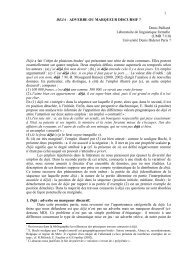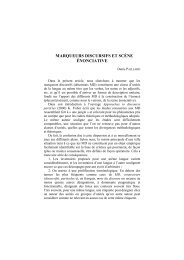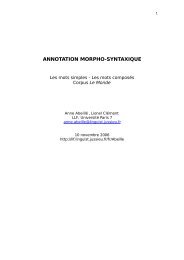CV as the only syllable type Jean Lowenstamm
CV as the only syllable type Jean Lowenstamm
CV as the only syllable type Jean Lowenstamm
Create successful ePaper yourself
Turn your PDF publications into a flip-book with our unique Google optimized e-Paper software.
esyllabification. 5 As such, it provides strong support for <strong>the</strong> crucial underlying<br />
<strong>as</strong>sumption that C's and V's strictly alternate in <strong>the</strong> makeup of <strong>the</strong> binyan.<br />
I now turn to evidence from Chaha documenting ano<strong>the</strong>r facet of <strong>the</strong> same<br />
claim, viz. <strong>the</strong> presence of an empty C between <strong>the</strong> two V positions forming a<br />
long vowel.<br />
2.2 Chaha Imperatives from a-final verbs, Long Vowels, and Straddled<br />
Empty Onsets<br />
Supporting evidence for this discussion comes from Imperative Feminine<br />
Singulars of a-final Chaha verbs. 6 Chaha, <strong>as</strong> most o<strong>the</strong>r Sou<strong>the</strong>rn Ethio-Semitic<br />
languages, lost <strong>the</strong> set of guttural consonants it presumably inherited from Proto-<br />
Semitic (Leslau 1957, 1960). An a (underscored in (12a)) appears where o<strong>the</strong>r<br />
Semitic languages (12b,c,d,e) display a guttural: 7<br />
(12)<br />
a. b. c. d. e. f.<br />
Chaha Ge'ez Tigrinya Arabic Hebrew Gloss<br />
qäTa-m qäS9a qaTa9a qaTa9 cut<br />
xäda-m<br />
b w äka-m<br />
käd9e<br />
bäx w 9e<br />
x<strong>as</strong>a9a betray<br />
ferment<br />
gäfa-m<br />
käpa-m<br />
gäf9a gäf9e<br />
käb9e<br />
žafa9a push<br />
fold<br />
däfa-m<br />
säma-m<br />
däf9a<br />
säm9a<br />
däf9e<br />
säm9e<br />
dafa9a<br />
sami9a šama9<br />
push<br />
hear<br />
Following <strong>Lowenstamm</strong> (1991), I take <strong>the</strong> vowel system of Ethio-semitic,<br />
hence of Chaha, to be <strong>as</strong> in (13) where all five peripheral vowels are long,<br />
5 The reader can verify that in nei<strong>the</strong>r c<strong>as</strong>e of (10), an empty nuclear position fails to be<br />
licensed by Proper Government from a full vowel to its right. As to <strong>the</strong> orthogonal question of why<br />
<strong>the</strong> mobile vowel <strong>as</strong>sociates where, <strong>the</strong> reader is referred to Guerssel & <strong>Lowenstamm</strong> (in<br />
preparation).<br />
6 Feminine Palatalization in Chaha is a rich and complex phenomenon. Space limitations<br />
preclude full discussion in <strong>the</strong> context of this paper. For a full discussion incorporating <strong>the</strong> analysis<br />
presented here, see <strong>Lowenstamm</strong> (in preparation).<br />
7 To simplify <strong>the</strong> discussion, <strong>the</strong> data in (12) is limited to c<strong>as</strong>es where Chaha a corresponds to<br />
<strong>the</strong> Proto-Semitic voiced fricative pharyngeal, 9. See Leslau (1957) for a richer set of examples. q is<br />
an ejective k; T is an ejective t; S is an ejective s; w indicates labialization; y indicates palatalization<br />
of a velar, e.g. g y , k y ; C, <strong>the</strong> result of <strong>the</strong> palatalization of T is an ejective palatoalveolar strident; j,<br />
<strong>the</strong> palatalized version of d is a voiced palatoalveolar strident; š is <strong>the</strong> palatalized form of s;<br />
palatalization of t results in <strong>the</strong> voiceless palatoalveolar c.


